When you hear about artificial intelligence (AI) generating content, what probably comes to mind is emotionless and robotic content. I’m thrilled to tell you that this doesn’t have to be the case. With a few tweaks here and there, AI can create human-like texts that sing! Picture your favorite writer crafting a profound piece or weaving a riveting tale. Imagine if an AI tool could replicate that very style with emotion-infused sentences, engaging narration, and witty humor. Let’s review how to accomplish this by “humanizing” AI content and mastering the human touch.
Definition of AI Content Humanization
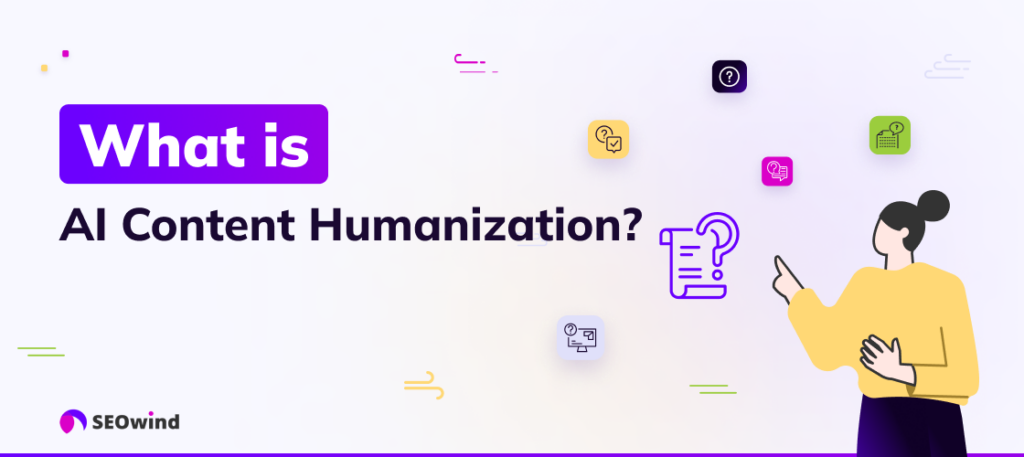
Right off the bat, let’s clarify what it means to “humanize AI content.” The process of imparting human qualities such as natural language understanding, emotional depth, creativity, and storytelling elements to artificially generated text is called AI content humanization.
This approach is all about mimicking human thought patterns and delivering them in a manner similar to how people speak or write. Does the concept still seem abstract? Consider chatbots, for instance. Notice how they converse? Behind their every response lies intricate programming that makes them sound more human and less robotic. They’re programmed with certain linguistic rules, so their responses resonate with users on a deeper level than a monotone robotic voice ever would.
Humanizing AI means adopting techniques where machine-generated utterances appear as though humans wrote them. To do so, you must achieve textual output from advanced algorithms in such a compelling way that it leaves readers wondering whether they are reading something created by an actual person or a machine.
Can GPT humanize AI content?
You know, tools like Humanize AI & Avoid Detection from SEOwind might actually pull it off. They’re all about taking AI-generated text and tweaking it until it feels like a real person put pen to paper (or fingers to keyboard, more likely). The idea here isn’t just to make the content look polished—it’s about crafting something that actually resonates with readers, something that feels natural and easy to connect with.
These tools work with some pretty nifty algorithms, spotting little grammar mistakes, playing around with sentence structure, and adding a touch of that friendly, conversational tone. Honestly, it’s a lot like having your own editor on standby, ready to give your writing a solid once-over. They manage to combine the speed and ease of AI with the kind of genuine, human touch that makes content truly stand out. Perfect for businesses, content creators, or anyone who wants to make sure their writing doesn’t just blend in but actually makes an impact.

How to humanize AI-generated content – webinar
If you would like to dive deeper into making your AI writing more human, watch my webinar below. We’ll delve into actionable insights and best practices that transform AI output into content that resonates with warmth and authenticity.
Inside this expert session, you can expect to uncover:
- Essential Guidelines for AI Content Creation: The Do’s and Don’ts,
- Hands-on Strategies for Infusing AI-Crafted Content with a Human Essence,
- Crafting the Perfect Tone of Voice for Audience Engagement,
- Streamlined Processes for Seamless human and AI collaboration,
- A Glimpse Into the Evolution of AI Content Development.
How to Humanize AI Content – The Ultimate Guide with 20+ Tactics
Let’s clear the fog together and discover how to breathe a touch of humanity into AI-generated content. What follows is your ultimate guide, complete with an infographic and a handy cheat sheet featuring over 20 tactics, to ensure every word resonates with a warm, human touch. After that, we go deep into each tactic and describe it in more detail.
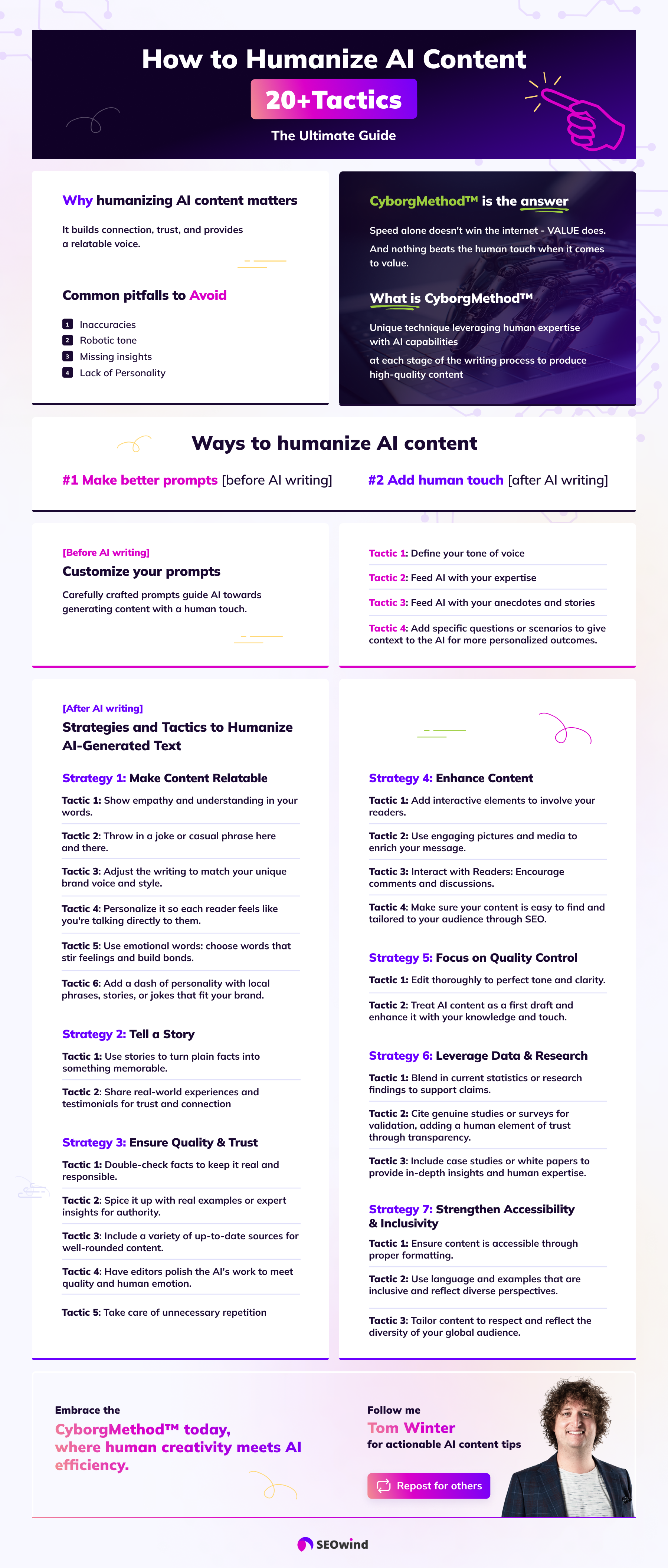
CyborgMethod™ – The Path to Truly Humanized Content
In the race to captivate audiences, speed is often mistaken for the ultimate weapon. Yet, let me share with you a little secret: it’s not about how fast you can churn out content; it’s about the value it holds. And what’s more valuable than imbuing your content with that irreplaceable human touch?
What Is CyborgMethod™?
At its core, the CyborgMethod™ is a unique approach that marries human expertise with the sophisticated capabilities of AI at every stage of the writing process. It’s all about producing content that resonates, content that brims with the warmth and insight only a human can truly provide. Think of it as a choreographed dance between human creativity and machine efficiency, producing a result greater than the sum of its parts. The result? High-quality content that resonates more deeply with your readers.
Ways to Humanize AI Content
The surest way to humanize your AI-crafted content doesn’t start after the content is generated; it begins at the very inception.
Let’s walk through how refining your prompts before engaging with AI can help you achieve just this.
[Before AI Writing] Customize Your Prompts
![[Before AI Writing] Customize Your Prompts](https://seowind.io/wp-content/uploads/2024/01/Ways-to-Humanize-AI-Content-1024x229.png)
Just as you’d guide a novice through new terrain with careful suggestions and wisdom, so too must you lead your AI with prompts that are meticulously crafted. These prompts steer your AI towards producing content that holds the warmth and relatability of human crafting.
Tactic 1: Define Your Tone of Voice
To start, articulate the tone of voice you’re aiming for. Is it professional yet approachable? Witty and irreverent? Or perhaps informative with a hint of storytelling flair? Precision in defining your tone paves the way for content that not only provides information but also reflects your brand’s personality.
Tactic 2: Feed AI with Your Expertise
The depth of your expertise is what sets you apart. Enrich your prompts with subject-matter insights and nuanced understandings only you possess. This infuses the resulting content with authority and authenticity that AI alone cannot replicate.
Tactic 3: Feed AI with Your Anecdotes and Stories
Stories are the lifeblood of engagement. They transform stark data into relatable narratives. Weave in your personal anecdotes or industry tales, and watch as the AI absorbs these stories, merging them into its output to create more compelling content.
Tactic 4: Add Specific Questions or Scenarios
Lastly, contextualize your expertise by integrating specific questions or scenarios into your prompts. This gives your AI a clearer understanding of the intended output, resulting in more finely tuned, personalized content.
Strategies and Tactics to Humanize AI-Generated Text [after AI Writing]
![Strategies and Tactics to Humanize AI-Generated Text [after AI Writing]](https://seowind.io/wp-content/uploads/2024/01/Strategies-and-Tactics-to-Humanize-AI-Generated-Text-after-AI-Writing-1024x229.png)
Once the AI has worked its magic, it’s not the end. It’s a draft awaiting the human touch that injects soul into the words. This is where you step in, reviewing, refining, and embellishing the AI’s output with personal insights, emotional depth, and that intangible human essence that no machine can replicate.
Strategy 1: Make Content Relatable
A good narrative thrives on rich storytelling components, such as dramatic arcs, active dialogues, and relatable characters. These are essential and offer readers an experience similar to living through the story rather than reading it off screens! Implement cliff-hanger strategies judiciously to leave readers anticipating what comes next and keep them glued!
Tactic 1: Show empathy and understanding in your words.
Adapt the content to reflect understanding, empathy, and an authentic human presence.
Tactic 2: Throw in a joke or casual phrase here and there.
Sprinkle in humor, rhetorical questions, or colloquialisms. These small touches can make your content resonate more with readers.
Tactic 3: Adjust the writing to match your unique brand voice and style.
Tailor it to your voice and brand by adjusting vocabulary, sentence structure, and cultural references.
Tactic 4: Personalize it so each reader feels like you’re talking directly to them.
Tailor content to resonate with individual preferences and interests, making each reader feel understood.
Tactic 5: Use Emotional Words: Choose words that stir feelings and build bonds.
Use emotionally charged words and phrases to evoke feelings and create a deeper connection with the audience.
Tactic 6: Add a dash of personality with local phrases, stories, or jokes that fit your brand.
Imagine you’re sharing a coffee with a friend rather than writing a sterile post. Inserting local idioms or recounting a short humorous anecdote with a twist of regional flavor can engage readers and bring them into your world. Just like a chef garnishes a dish with fresh herbs, a well-placed local saying or lighthearted joke can add that zest to your content, making it distinctly yours and deliciously memorable.
Strategy 2: Tell a Story
To humanize AI-generated text, we need to transform the out-of-the-box, automated content into engrossing narratives that echo authentic human storytelling. It’s about adding depth and soul to words churned out by artificial algorithms, making them more relatable and touching.
Tactic 7: Use stories to turn plain facts into something memorable.
Incorporate narratives and anecdotes to provide context and depth, transforming facts into memorable stories.
Fill your content with anecdotes that underscore your points. Even in the most seemingly ordinary tales, people often respond emotionally when they can relate on a personal level.
Tactic 8: Share real-world experiences, testimonials, or personal stories for trust and connection.
Personal stories and real-life examples resonate and create trust. Weave in testimonials, case studies, or personal narratives to give a human perspective to the information AI provides.
Strategy 3: Ensure Quality & Trust
It’s about fostering a bond of trust with your readers through meticulous attention to detail, not just in the information you present but in the way you present it.
Tactic 9: Double-check facts to keep your content accurate and responsible.
Vigilant editing is essential for aligning AI content with human values, accuracy, and ethical standards. Fact-checking is crucial for maintaining credibility.
Fact-checking is indispensable in preserving credibility and building reader trust. Verify every bit of provided information, particularly statistics, facts, and current event references, which can either affirm the validity of your content or erode it if inaccurate.
Tactic 10: Spice it up with real examples or expert insights for authority.
Consult with experts in relevant fields to validate facts and provide authoritative quotes, which can lend credibility to your content.
Tactic 11: Include a variety of up-to-date sources for well-rounded content.
AI may rely on a limited dataset. Enrich your content with diverse sources, including recent studies, expert interviews, and trending news.
Tactic 12: Have editors polish the AI’s work to meet quality and human emotion.
Enlist human editors to refine AI-generated text, ensuring it meets quality standards and reflects human sentiments.
These are foundational aspects of any written piece. No matter how insightful or engaging your narrative, grammatical or spelling mistakes can discredit it quickly. They disrupt reading fluency and reflect negatively on your credibility.
Take time to go through the material line by line. Even advanced tools might overlook an occasional typo or misconstrue homonyms (words that sound identical but possess different meanings). Such instances necessitate human intervention to correct.
Tactic 13: Take care of unnecessary repetition
Unwitting repetition is a common issue with AI-generated content, where it might reiterate similar ideas or use identical words repeatedly within short intervals. This could affect readability negatively as repetitive text tends to bore readers faster than varied narratives.
Strategy 4: Enhance Content
This strategy revolves around the notion of enhancement, fine-tuning your content till it resonates on a deeper level with your audience. It involves crafting a lively and interactive canvas where readers feel part of the narrative, rather than mere observers. Let’s go through the tactics that can transform your content from static text to a vibrant and engaging masterpiece.
Tactic 14: Add interactive elements to involve your readers
Visuals, videos, and other media elements catch attention and aid comprehension. Source or create unique images, infographics, or multimedia to supplement the text and break up the AI-generated content to make it more engaging.
Tactic 15: Use engaging pictures and media to enrich your message
Visuals add depth and texture, making content more memorable and impactful.
Tactic 16: Interact with Readers: Encourage comments and discussions.
Pose questions, invite comments, or suggest actions to provoke reader engagement, making your content a two-way conversation.
Tactic 17: Make sure your content is easy to find and tailored to your audience through SEO.
Use SEO to make your content discoverable and relevant to search intent.
Strategy 5: Focus on Quality Control
This strategy zooms in on the crucial phase of editing, where the authenticity and clarity of AI-created content are honed. It’s about perfecting the AI draft, transforming it into a polished piece that resonates deeply with the audience. Now, let’s delve into the tactics and see how they collectively contribute to elevating AI content to human standards.
Tactic 18: Edit thoroughly to perfect tone and clarity.
Edit with care to refine tone, eliminate errors, and ensure the content speaks directly to the reader.
A well-told story has a logical flow where ideas link seamlessly within the defined context or theme. As a reviewer, you ensure each sentence ties in naturally with its surrounding content without introducing confusion or ambiguity.
Moreover, the topics should stay relevant to your original intent throughout the entire text. Straying off-path could confuse readers and dilute the primary message’s potency.
Tactic 19: Use bullet points and ordered lists
Break down complex points into simpler ones for easy digestion by implementing itemized listing strategies.
Tactic 20: Treat AI content as a first draft and enhance it with your knowledge and touch
View AI-generated content as a starting point, shaping it with additional insights and personal expertise.
Strategy 6: Leverage Data and Research
Nothing speaks more powerfully than the voice of data-infused with human curiosity and analysis. By leveraging rigorous data and research, we ground abstract artificial intelligence in the concrete, quantifiable realm of human understanding. Let’s explore the specific tactics that transform figures and studies into vivid narratives that resonate with the logic and emotions of our audience.
Tactic 21: Blend in current statistics or research findings to support claims.
Integrating up-to-date statistics or findings from recent research adds a layer of credibility to AI-generated content. It’s like bringing a well-respected expert into the conversation. This doesn’t just bolster the argument at hand, but it also demonstrates a commitment to being informed and factual, which helps build trust with your audience.
Tactic 22: Cite genuine studies or surveys for validation, adding a human element of trust through transparency.
Think of each study or survey you mention as a handshake between your content and the reader – it’s a gesture of goodwill and honesty. By citing authentic research, you’re essentially promising that there’s a tangible, human foundation to the information you present, fostering a sense of reliability and trust.
Tactic 23: Include case studies or white papers to provide in-depth insights and human expertise.
If your content is a bridge between knowledge and your audience, case studies and white papers are the strong cables that support it. They don’t just offer surface-level information but allow for a deep dive into real-world applications and human-centered analysis, showcasing the rigorous thought processes behind the concepts discussed.
Strategy 7: Strengthen Accessibility and Inclusivity
This strategy underpins the essence of inclusivity and accessibility, making certain that the rich tapestry of human experiences is acknowledged and catered to in our content creation. Let’s delve into the responsive tactics that assure our communications resonate universally, embodying the values of inclusiveness and equal access for every individual.
Tactic 24: Ensure content is accessible to different audiences through proper formatting.
Content that’s accessible is like an open-door policy – it welcomes everyone into the room. By employing proper formatting like alt-text for images, transcripts for videos, and clear headings for text, you cater to the needs of different individuals, ensuring that your content is an inclusive resource for information.
Tactic 25: Use language and examples that are inclusive and reflect diverse perspectives.
Diversity in language and examples acts as a mirror, reflecting the multifaceted nature of your audience. This approach acknowledges and celebrates a range of experiences, inviting a broader dialogue and ensuring everyone sees a bit of themselves in your message. It’s a powerful way to build a connection with your readers from all walks of life.
Tactic 26: Tailor content to respect and reflect the diversity of your global audience.
When your content is sensitive to the cultural, geographic, and societal diversity of your global audience, it’s like providing a hospitable environment where all are welcomed and appreciated. Adjusting your content to be respectful and reflective of this rich tapestry of human experience deepens the reader’s sense of belonging and engagement.
Benefits of Humanizing AI Content
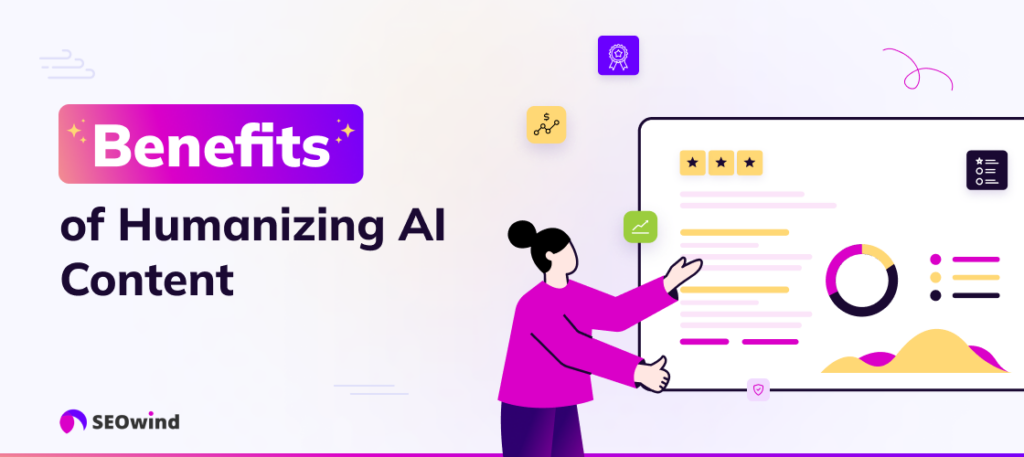
As AI continues to proliferate, it’s essential to remember that the human touch plays a pivotal role in content creation. It’s time to shed some light on the importance of creating content that resonates with readers on a deeper level.
Building Trust and Engagement with Readers
One of the foremost advantages is forming stronger connections between your brand and audience. By integrating authentic human elements into AI-generated narratives, you’re crafting stories with relatable contexts that provide value rather than just generating content. This helps in building trust among your readers.
Harvard Business Review’s study about investor responses to earning calls demonstrates this benefit. The findings showed investors reacted more positively when CEOs presented information in stories rather than abstract terms. This is how storytelling can invoke emotions and improve engagement!
As digital trends shift toward conversational commerce, a fast-emerging trend wherein businesses interact with customers via messaging apps, humanizing automated output becomes even more significant.
Enhancing User Experience and Satisfaction
Another critical benefit is enhancing the user experience (UX). Since UX design is inherently aimed at humans, developing an emotional resonance with users through humanized messages ultimately improves satisfaction.
Spotify’s personalized playlists like Discover Weekly or Daily Mixes are solid examples. Built using complex algorithms and numerous datasets, these features still feel personal because they echo our music preferences so accurately. Isn’t it satisfying when Spotify suggests songs that you end up loving? That’s the power of competent AI-human integration!
Additionally, studies such as one published by Academia highlight the significance of emotion in UX design, asserting that positive emotions induce loyalty towards services or products while negative ones may lead to abandonment.
Improving SEO and Organic Traffic
Finally, humanized AI content offers substantial search engine optimization (SEO) benefits. Search engine algorithms have become sophisticated enough to scrutinize the quality of content served to users, focusing on how engaging and valuable it is aside from mere keyword relevance.
Google’s BERT update, an AI language processing algorithm, evaluates the context and intent behind search queries, prioritizing pages that best answer user questions over ones only stuffed with keywords.
Thus, by generating content that mirrors human conversation and context awareness, you’re upping your game in terms of SEO performance while simultaneously driving organic web traffic growth. Deloitte’s study on machine learning shows businesses harnessing advanced technologies such as AI report higher productivity and increased market share, indicating that success isn’t bound to human effort anymore.
It’s safe to say that the benefits of humanizing AI content extend much further than improving reader engagement or the user experience alone. We’re looking at a comprehensive transformation where multiple facets like SEO optimization also receive ample boosts!
Why humanizing AI content is necessary for better user experience
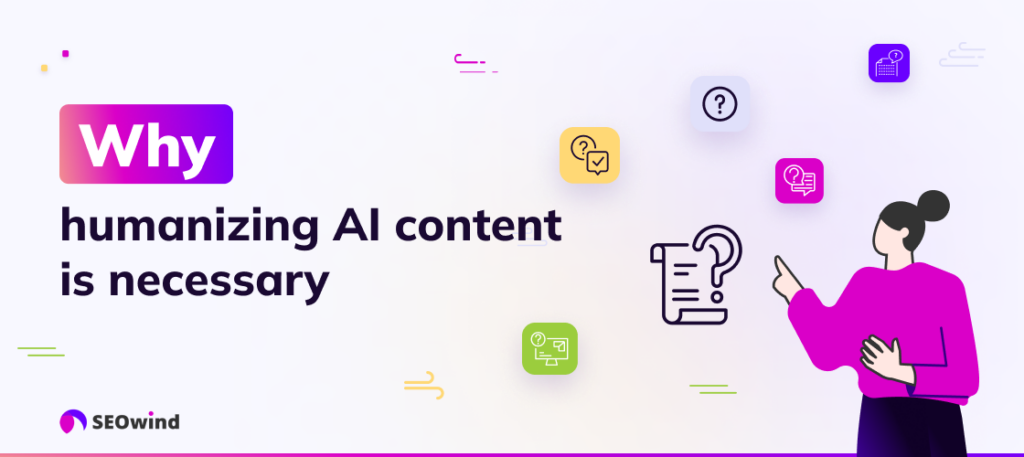
With the rise of digital technology and artificial intelligence, we have seen an unprecedented shift in how businesses operate online. Content producers increasingly rely on AI-powered, automated text generators to meet their high-volume content needs. However, regardless of how capable these machines become at crafting language, they lack one crucial element: a human touch.
AI-generated content indeed delivers efficiency and scalability but often lacks depth, character, and empathy, elements that breathe life into written words. This is where humanization comes into play. With humanized AI content, you balance machine efficiency and human-like authenticity.
Challenges & Solutions for Humanizing AI Content
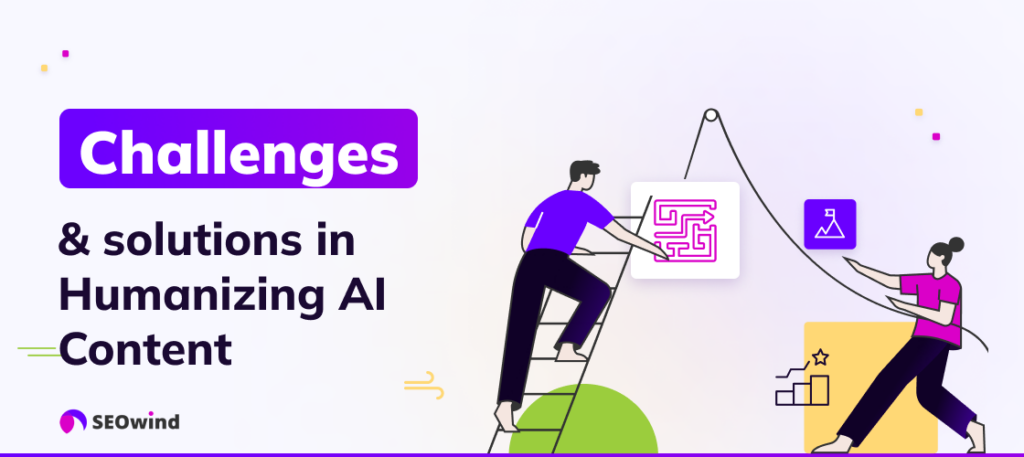
There are several pitfalls when it comes to humanizing content generated by AI. Let’s take a look at these challenges and how you can address them.
Lack of Empathy
Although highly sophisticated, AI often lacks an understanding of feelings and emotions. It creates technically accurate content that lacks the warmth and friendliness necessary to engage readers on an emotional level.
This can be solved by incorporating frameworks that analyze sentiment, tone, and emotionality can drastically improve empathy in artificial intelligence writing systems. Advanced NLP tools should consider valence (emotional value) and semantic meanings.
Absence of Creativity
AI lacks the unpredictability and original thoughts a human mind generates. While AI can mimic patterns and styles, the creative flair that often resonates with audiences may be absent.
Bridging Creative Gaps Through Training might help. Using wide-ranging source materials spanning various genres during the training phase and incorporating diverse human thinking processes will improve creativity within your digital writer’s output.
From Syntax to Semiotics
Although perfectly capable of identifying and applying grammatical rules, language is more than the syntax for humans. It’s also about nuance, context, connotation, and subtext that machines struggle to grasp fully.
How to handle it? Tools based on NLP can comprehend slang, idiomatic expressions, and societal references. By effectively using these tools, you can achieve a massive jump in making AI understand context and nuance.
Discrepancies in Tone and Voice
Keeping a consistent tone or voice throughout a piece of content becomes difficult as AI may not fully understand nuances from one paragraph to the next.
Like any writer, AI needs to learn your brand voice. Regularly reviewing AI outputs and providing graded feedback helps the system learn an individual or company’s voice. For instance, brand A is consistently formal, while brand B favors informality.
Failure to Fully Understand the Context
AI models are still learning how to handle context effectively. This might lead them to generate content that is misconstrued by users or cause unintended negative consequences.
Triangulating Context might be a good solution. A check-and-balance system is beneficial so that each statement generated by the AI model is checked for contextual relevance from multiple standpoints. This primarily focuses on cultural sensitivity, socio-political implications, and historical honesty, among others.
Acknowledging these challenges upfront and employing appropriate solutions to overcome them makes humanizing AI writing convincingly possible while retaining all the benefits of automated content creation. Moreover, these solutions help us avoid uncanny linguistic valleys where robots almost sound human but give away their nature by missing some vital characteristics of natural language use.
Impactful Use Cases of Humanized AI Content
Real-world examples can offer valuable insight into how harnessing the power of a personal touch in AI writing can manifest notable results. Let’s look at some impactful use cases of humanized AI content;
- One of the best examples comes from e-commerce giant Amazon. Machine learning algorithms power its product recommendation system and add a personal shopping assistant function to its communication strategy. The AI mimics personalized suggestions a human makes and promotes products closely aligned with users’ preferences and past purchase history.
- BetterHelp, an online therapy platform, uses chatbots programmed to replicate human tones and emotive language to communicate effectively and quickly with users who need help.
- This is where SEOwind shines, too! My company incorporates the CyborgMethod™ in its practices, encouraging collaboration between humans and AI for superior content creation.
These innovative practices demonstrate what we can achieve when we effectively leverage the capacity to humanize our technologically advanced tools.
Creating a Connection with Users through Personalized Messaging
So, how do we initiate this connection? It begins with personalized messaging, a tactic gaining priority in today’s fast-paced digital ecosystem. Endowing each message with emotional elements engages your audience on more intimate terms.
Start by incorporating dialogue or conversation starters in your text. Think of questions or striking statements that would generate curiosity among your readership like SEOwind does in its content offers. Style your brand’s tone of voice according to your audience demographic, which you can learn from data trends and user interactions.
Nevertheless, don’t get preoccupied with the humanizing process to such an extent that your communication seems forced. You’re seeking human-like AI content, not mimicking humans. Understanding this difference is also essential to mastering the art of humanizing AI-generated text.
Over time, this approach will convert more users because they can sense authentic communication, even if it comes from machine algorithms. In short, whether we realize it or not, we’re already beginning to embrace a future where bespoke messages powered by humanoid AI are the norm rather than the exception.
Tools and Technologies for Humanizing AI Content
Exactly how human can we make AI? Several AI humanizer tools are at your disposal to tackle this issue. Here, let’s cover some of the popular options.
SEOwind – AI writer that writes human-like content
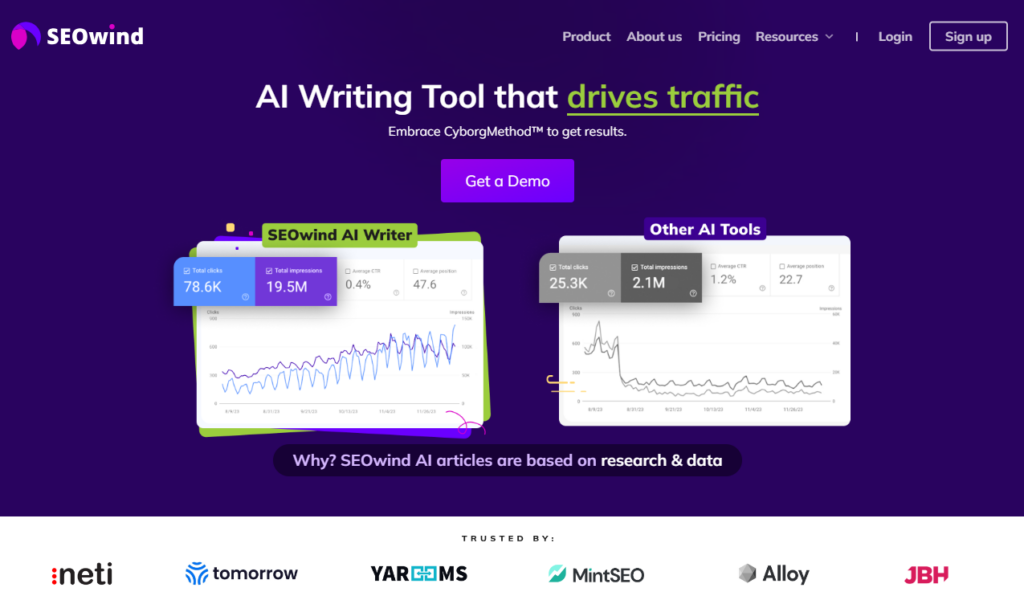
Built by experienced professionals in SEO, content marketing, and AI, SEOwind merges machine intelligence with human creativity to generate vibrant, high-quality content. It’s equipped with superb features such as:
- in-depth content research,
- comprehensive outline creation,
- the tone of voice customization,
- defining company, product and services, and target audience,
- adding additional relevant statistics and quotes, and more
Supporting 12 languages, including English, Spanish, and German, SEOwind has truly encompassed universal usability. Recognized for its “CyborgMethod™,” it sincerely integrates the human touch into its services.
SEOwind GPT – AI Humanizer & Avoid AI Detection
SEOwind GPT AI Humanizer specializes in transforming AI-generated content into writing that reads as if it were crafted by a real person. It takes the highly polished, yet often sterile text produced by AI and infuses it with a natural, human touch. The goal is to make content sound warm, relatable, and convincingly genuine, avoiding the pitfalls of machine-like language.
At its core, this tool blends editing, rewriting, and storytelling techniques. It breaks down the original text, then reconstructs it with varied sentence structures, colloquial language, and the kind of quirks and nuances found in everyday conversation. Whether it’s adding a dash of humor, a casual aside, or a relatable analogy, this tool aims to shape content in a way that feels fresh and authentic. The result? Text that can evade AI detection systems while engaging readers with a voice that seems to carry a unique personality and a bit of a backstory.

OpenAI GPT-4
This state-of-the-art technology utilizes Generative Pre-training Transformer algorithms that help write meaningful sentences within an established context. While perfect for scripting engaging texts from scratch or enhancing existing pieces to sound more organic, it demands careful handling from experienced users. The outcome highly depends on your skills in prompt engineering.
As each tool seeks to augment the user experience by mimicking authentic human conversation styles in its own way, it needs strict operating standards to ensure ethical use of the technology’s immense capabilities.
Impact of Humanized AI Content on SEO
Search Engine Optimization (SEO) plays a significant role in the vast digital landscape. It’s an essential strategy to make your content discoverable among billions of web pages crawled by search engines daily. And this is where humanized AI content shines.
Discussion on how humanized AI content can improve search engine rankings
AI that generates content has come a long way. However, it doesn’t mean all AI-generated text is user-friendly and optimized for search engines. Ensuring your AI copies have a human touch enhances the reader experience and significantly improves the performance of those pages in Search Engine Results Pages (SERPs).
Firstly, humanizing your AI content means balancing technical SEO (keywords density, proper usage tags, etc.) and engaging narrative style that appeals to your customers or readers. Quality content that connects with readers sends positive signals to search engines, indicating that your page provides value and encourages higher ranking on the result pages.
It’s important to note that some essential elements of SEO, like backlink building and social shares, heavily depend on creating high-quality, relevant, and engaging content, something machine-generated pure data won’t achieve as efficiently as narratives with added human experiences.
Furthermore, the systematic implementation of named entity recognition (NER), an application under Natural Language Processing used by Google to understand the context of specific keywords within a text block, becomes more potent in human-like texts than in otherwise numeric-based compositions.
Tips on optimizing humanized AI content for better SEO performance
Now let’s explore some actionable tips you can use to optimize your humanized AI content for improved SEO performance:
- Identify Appropriate Keywords: Utilize keyword research tools to identify appropriate keywords relevant to your topic. Integrate them effectively into your AI-generated text without overstuffing.
- Mind Your Tags: Use important SEO tags: Title Tag, Meta Description, and Header Tags (H1 to H6). These are critical places where your keywords should appear.
- Invest in High-Quality Content: A well-structured, engaging content is vital. Even when AI plays a part in writing, ensure it doesn’t sound robotic but conversational and natural while still being information-packed.
- Encourage Social Shares: Humanized AI content with emotional engagement tends to encourage social shares, leading indirectly to SERP improvement.
- Add Multimedia Elements: Mixing texts with relevant images, infographics, or video content helps keep the audience engaged on your page longer.
- Keep Optimizing Regularly: SEO is an ongoing process, so monitor how your pages perform and refine them as needed for improvement.
By aligning human touches efficiently with the features of AI-generated text, like consistency or speed, you get optimal content that satisfies users’ desires for engaging material and technical requirements set by search engines to rank higher on their lists.
Who Can Benefit from Humanize AI Text Tools
The ability to infuse a human touch into AI-generated texts is not limited to specific industries or professions. However, some fields are uniquely positioned to reap immense benefits from mastering this art. Today, let’s focus on three groups: marketers and copywriters, e-commerce businesses, content creators and bloggers.
Marketers and Copywriters
Firstly, there are our dedicated marketers and copywriters. These professionals must often juggle various tasks at once, from drafting compelling ad copies and engaging social media posts to crafting persuasive emails and informative blog articles.
AI text tools can help simplify this workload by generating first-cut write-ups efficiently. To engage their audiences better and evoke desired actions like clicks, shares, and purchases, these initial drafts must sound more authentic and less robotic. This is where the skills of humanizing AI-produced content take center stage.
With strategic alterations like adding warmth, humor, relatability, and even an empathetic tone, marketers and copywriters can create high-quality content that resonates with their audiences while reducing production time drastically.
E-commerce Businesses
The e-commerce sector is another beneficiary worth noting. As consumers increasingly opt for online shopping experiences due to their convenience, an e-commerce business’s success hinges on developing genuine connections with potential customers amid market saturation.
Tailored product descriptions that emulate human-like conversations play a significant role in achieving that connection on virtual platforms. Giving your digital products a voice can foster deeper customer relationships based on trust built through immersive shopping experiences!
Content Creators and Bloggers
Finally, we have content creators and bloggers. From informative pieces to op-eds, this cohort constantly strives to captivate readers with unique narratives.
While AI can help generate initial drafts to work on, adding personal anecdotes, emotional touchpoints, and a signature writing style helps humanize such text considerably. The result? Engaging content that keeps the reader informed and connected on a more human level enriches their reading experience!
In essence, any profession involving content generation can benefit from learning how to humanize AI-generated texts. It’s about augmenting rather than replacing your creative prowess!
Final thoughts on the importance of humanizing AI content for better user experience and engagement
Reflecting on our discussion about humanizing AI content, one thing stands out: its significant impact on user experience and engagement. You’ve journeyed with me through the intricacies of defining, understanding, and implementing humanization techniques in AI-generated text. The question now is how you intend to harness this powerful tool in your daily operations.
Humanizing AI is not simply a marketing buzzword or a fleeting trend. It’s an essential strategy for maintaining relevancy in an increasingly digitally-driven world. As more businesses leverage AI technologies to power their content creation process, there’s a pressing need to ensure these technologies still evoke that quintessential human touch that fosters connection and engagement.
Remember, behind every readable document or engaging copy, there’s often a person yearning for genuine connection and interaction. How do we achieve this bond? By infusing elements of emotion, humor, personal stories, and relatability into our artificially generated outputs.
You may wonder if all this effort is worthwhile, but let me assure you that research firmly underscores the potency of personalized communication in strengthening brand-consumer relationships. Ultimately, it will generate a better user experience and heightened engagement rates that are benchmarks of success in today’s competitive marketplaces.
This isn’t about replacing humans with machines but rather evolving machines to reflect our richest human qualities—our emotions, creativity, and intuition—to add value where only they can truly shine: automation at scale while preserving personal touch points effectively.
Common Questions On How to Humanize AI Content
As you navigate the world of humanizing AI-generated content, you might have many questions. Let’s delve into some frequently asked queries and address them effectively.
How Do I Humanize ChatGPT Content?
Humanizing ChatGPT content is a task that necessitates a few critical steps. Firstly, understand your audience and their interests. Personalization can make even machine-generated texts feel human. Customize messages using language consistent with your brand’s voice and pepper in details specific to the user when possible.
Secondly, incorporate emotions like humor or empathy where suitable. It can work wonders in making AI content more relatable. But overdoing it can lead to seeming out of touch or insincere. Balance is essential here!
Lastly, fine-tune anywhere the content feels distinctly robotic. This exercise includes checking for errors and adjusting any overly technical jargon into simpler terms that anyone can comprehend.
How Do I Humanize AI Content Perfectly to Fit Human Content?
Perfecting the art of humanizing AI content necessitates understanding quintessential human qualities — sincerity, authenticity, and emotionality — and subtly incorporating these elements throughout your written material.
To foster what seems like human interaction with written text requires practice. Consider adding anecdotes or casual expressions, which can give audiences comfort and connection. Moreover, vary sentence lengths to mirror typical conversational rhythms.
Also, never underestimate the power of storytelling. Utilizing narratives within your AI writing establishes personality while engaging your readers profoundly.
How do I Rewrite AI Content to Give It a Human Touch?
While rewriting AI content may initially seem daunting, following these strategic steps will instill confidence and allow you to narrate compelling stories seamlessly;
- Start by evaluating how coherent the narrative is. Make sure the text flows organically and makes sense to your readers.
- Next, double-check if any corrections, such as spelling errors or contradictory information, are necessary.
- Incorporate a range of sentence structures to avoid monotony and maintain reader interest.
- Add conversational elements like contractions, everyday phrases, or questions directed at the audience for increased engagement.
While AI has drastically simplified content generation in many regards, our human touch truly elevates the reading experience for our audience!


